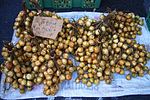| Baccaurea motleyana | |
|---|---|

| |
| Scientific classification | |
| Kingdom: | Plantae |
| Clade: | Tracheophytes |
| Clade: | Angiosperms |
| Clade: | Eudicots |
| Clade: | Rosids |
| Order: | Malpighiales |
| Family: | Phyllanthaceae |
| Genus: | Baccaurea |
| Species: | B. motleyana |
| Binomial name | |
| Baccaurea motleyana Müll.Arg. | |
| Synonyms | |
| |
Baccaurea motleyana is a species of fruit and fruit tree which grows wild in parts of Southeast Asia and is cultivated for its fruit in India, Bangladesh, Indonesia, Thailand and Peninsular Malaysia.
Names
The specific name is after botanist James Motley, who collected it in southeast Borneo.
Its common names include rambai and rambi, and in Thai language mafai-farang. In the Bengali language the fruit is known as bubi as local language in Narsingdi like lotka, lotkon or bubi in Bengali locally (লটকা/লটকন/বুবি), in the Assamese language it is known as leteku (লেটেকু).
Description
This is a tree generally growing to 9 to 12 meters (30 to 39 ft) in height with a short trunk and a broad crown.
The evergreen leaves are shiny green on the upper surface and greenish-brown and hairy underneath. Each leaf is up to 33 centimeters (13 in) long and 15 centimeters (5.9 in) wide.
The species is dioecious, with male and female flowers growing on separate individuals. Both types of flowers are fragrant and have yellow sepals. The staminate racemes are up to 15 centimeters (5.9 in) long and the pistillate inflorescences may reach 75 centimeters (30 in) in length. The fruits are each 2 to 5 centimeters (0.79 to 1.97 in) long and about two wide and grow in strands.
Each fruit has velvety pinkish, yellow, or brown skin which wrinkles at ripening and is filled with whitish pulp containing 3 to 5 seeds. The pulp is sweet to acid in taste. They may be eaten raw or cooked or made into jam or wine.
Uses
The tree is also used for shade and low-quality wood.
Gallery
-
The tree with fruits
-
 Fruits
Fruits
-
Inside of the fruits
-
Young fruits of Baccaurea motleyana (Phyllanthaceae)
References
- "WCSP". World Checklist of Selected Plant Families. Retrieved 5 January 2022.
- Prodr. (DC) 15.2 p.461 (1866)
External links
This Phyllanthaceae article is a stub. You can help Misplaced Pages by expanding it. |